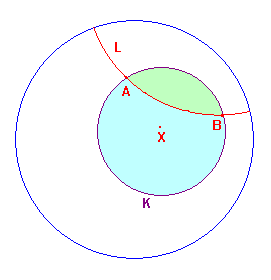the hybrid angle theorem
Suppose that A,B,C are points in the disk, with A ≠ B.
If A,B,C lie on a circle K with centre O, then
cos(e(ACB)) = (s2(AC)+s2(BC)-s2(AB))/2s(AC)s(BC).
proof
The euclidean lengths are given by the distances theorem.
Now apply the euclidean cosine rule to ΔABC. The factors
involving c(OA), c(OB), c(OC) cancel since OA,OB,OC are radii
in both the euclidean and hyperbolic sense.
Remark Since hyperbolic length of XY, and hence s(XY) are
hyperbolic invariants, the quantity which appears on the right
is also an invariant of the hyperbolic triangle ΔABC, though it
will not correspond to the euclidean angle at C in general.
Definition
If A,B,C are distinct points on the disk, define
E(A,B,C) = (s2(AC)+s2(BC)-s2(AB))/2s(AC)s(BC).
The function E gives yet another characterization of circumcircles.
More importantly, it aso allows us to describe the major and minor
arcs when AB is not a hyperbolic diameter. Suppose that we apply
a hyperbolic transformation so that the hyperbolic (and hence the
euclidean) centre is at O. Then the major and minor arcs agree in
both geometries. From the euclidean picture, C lies on ther major
arc if and only if <ACb is acute. Since E is a hyperbolic invariant,
we have the
characterisation of minor and major arcs
If AB is not a hyperbolic diameter of the hyperbolic circle K,
and C lies on K, then C lies on the major arc in the hyperbolic
sense if and only if E(A,B,C) > 0.
We will also require the following algebraic result :
the F-H relation
If F(x,y,z) = x2+y2-z2/2xy,
then 1-F2(x,y,z) = H(x,y,z)/4x2y2.
The proof is simply an algebraic manipulation from the given formulae
for E and H.
|
Note Since the (hyperbolic) centre
is O,
K is a also euclidean circle with centre O. |
|
We shall begin by looking at the case where AB is a diameter.
the hyperbolic semi-circle theorem
Suppose that A,B,C are points in the disk, with A ≠ B, and that K
is the hyperbolic circle on AB as diameter. Then C lies
on K if and only if s2(AC)+s2(BC) = s2(AB),
inside K if and only if s2(AC)+s2(BC) < s2(AB),
outside K if and only if s2(AC)+s2(BC) > s2(AB).
proof
We apply the origin lemma so the centre of the circle is O.
Then AB is a euclidean diameter and so C lies on the circle
if and only if e(ACB) = π/2, i.e. cos(e(ACB)) = 0, etc. (part (7)).
The results
now follow from the hybrid angle theorem.
We can, of course also state the result in hybrid form:
the hybrid semi-circle theorem
Suppose that A,B,C are points in the disk, with A ≠ B. Then
C lies on the hyperbolic circle with diameter AB if and only if
the euclidean (s(AB),s(BC),s(CA)) triangle can be inscribed
in a euclidean circle with diameter s(AB).
|
We may restate the condition for C on K as
if and only if the euclidean triangle
(s(AB),s(AC),s(BC))
is right-angled. |
